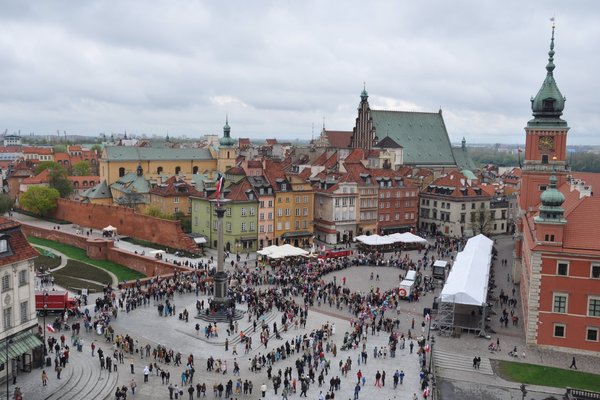Poland
Warsaw
The Historic Centre of Warsaw is a near-total reconstruction of a city center from the 13th to 20th centuries.
Warsaw was razed in August 1944 by Nazi occupation troops to repress Polish resistance. About 85% of the city was destroyed. After the war, a reconstruction campaign was started to recreate its late 18th-century appearance. This resulted in the rebuilding of monuments like the Cathedral of St John and the Town Market Square. The project contributed significantly to the conservation practice of European cities after World War II.
Community Perspective: The reviews by Ian, Clyde and James will give you a good overview of what to expect and what to see. All agree that the reconstruction was done outstandingly.
Site Info
Official Information
- Full Name
- Historic Centre of Warsaw (ID: 30)
- Country
- Poland
- Status
-
Inscribed 1980
Site history
History of Warsaw
- 1980: Inscribed
- Inscribed
- 1979: Deferred
- Bureau - ICOMOS supports but concern about reconstruction -Bureau divided!
- 1978: Deferred
- Bureau - ICOMOS want more info
- Type
- Cultural
- Criteria
- ii
- vi
Links
- UNESCO
- whc.unesco.org
- Official
-
- warsawtour.pl — Warsaw Tourist Office
All Links
UNESCO.org
- whc.unesco.org — whc.unesco.org/
Official Website
- warsawtour.pl — Warsaw Tourist Office
Community Information
- Community Category
- Urban landscape: Urban continuity
Travel Information
Recent Connections
-
European Route of Historic Gardens
Gardens of The Royal Castle in Warsaw (…
-
Modern Board Games
Warsaw: City of Ruins (2016) -
European Garden Heritage Network
The Gardens of the Royal Castle in Wars…
Connections of Warsaw
- Individual People
-
-
Hitler was here
He received the Wehrmacht parade in Warsaw on October 5, 1939. -
King Chulalongkorn of Siam (Rama V)
(1 July) met Prince Imeritinsky, Governor of Poland -
Napoleon was here
"Climb up ul. Kamienne Schodki to get back into the main square. Not only is this the longest stairwell in Old Town, it?s also where Napoleon allegedly stood in 1806, pensively staring eastwards as he planned his campaign against Russia"
-
- Geography
-
-
Vistula
-
Located in a Capital City
Warsaw (Capital of Poland)
-
- Trivia
-
-
Depicted in Mizielinska Maps
Castle and Waza StatueSee i.pinimg.com
-
Modern Board Games
Warsaw: City of Ruins (2016)
-
- History
-
-
Insurrections
Warsaw Uprising (1 August - 2 October 1944)See en.wikipedia.org
-
Second World War
The destruction of Warsaw was Nazi Germany's substantially-effected razing of the city in late 1944, after the 1944 Warsaw Uprising of the Polish resistance. .. the destruction of Warsaw did not serve any military or colonial purpose; it was carried out solely as an act of reprisal. The Old Town Market Place was destroyed and rebuilt after the War.See en.wikipedia.org
-
Diplomatic Missions of Joseon Envoy Min Yonghwan
18 May 1896 (Lunar date: 6/4) Clear weather. "At 11:00 A.M. we set off again, travelling 400 leagues. At 2:00 P.M. we arrived in Warsaw, the former capital of Poland...I heard that this country used to be a most enlightened and independent country, but more than a hundred years ago it gradually became politically weakened. Officials and nobles mistreated the people, and there were frequent rebellions. These could not be suppressed, and finally the three countries Russia, Austria, and France divided the land between them. Perhaps this is a warning to those who are governing our country ..At night outside the shops on either side of the street, torches can be seen burning like a continuous rope of fire. This is the first time we have seen such a thing since we came to the West."
-
- Damaged
-
-
Damaged in World War II
Late 1944, German forces dedicated an unprecedented effort to razing the city, destroying 80–90% of Warsaw's buildings, including the vast majority of museums, art galleries, theaters, churches, parks, and historical buildings such as castles and palaces. (wiki)See en.wikipedia.org
-
- World Heritage Process
-
-
OUV provided by Reconstructions
"Criterion (vi): The Historic Centre of Warsaw is an exceptional example of the comprehensive reconstruction of a city that had been deliberately and totally destroyed. The foundation of the material reconstruction was the inner strength and determination of the nation, which brought about the reconstruction of the heritage on a unique scale in the history of the world. -
Inscribed at third attempt or more
Def 1978, Def 1979, Ins 1980
-
- Religion and Belief
-
-
Cathedrals
St Johns, Cath of St Michael Arch + St Florian, Co-Cath of Our Lady of Victory
-
- Human Activity
-
-
Tramways
-
Paintings by Venetian Vedutisti
Warsaw (Bellotto)
-
- Constructions
-
-
Monumental Columns
Sigismund's Column "originally erected in 1644, is located at Castle Square, Warsaw, Poland and is one of Warsaw's most famous landmarks as well as the first secular monument in the form of a column in modern history. The column and statue commemorate King Sigismund III Vasa, who in 1596 had moved Poland's capital from Kraków to Warsaw."
-
- WHS on Other Lists
-
-
European Route of Historic Theatres
Baltic Route: Royal Theatre in the Old OrangerySee www.erht.eu
-
European Route of Historic Gardens
Gardens of The Royal Castle in Warsaw (Link)
-
World Monuments Watch (past)
Próżna Street (1996) -
Memory of the World
Warsaw Reconstruction office, Warsaw Ghetto Archives - Emanuel Ringelblum Archives (Jewish Historical Research Institute, Warsaw) -
The Jean-Paul-L’Allier Prize for Heritage
2009: Lighting of the walls of the Historic Centre -
Network of European Royal Residences
Royal Castle in Warsaw -
European Garden Heritage Network
The Gardens of the Royal Castle in WarsawSee www.eghn.org
-
- Timeline
-
-
Built in the 20th century
Its OUV lies in the reconstruction techniques and effort, that happened after 1945
-
- Science and Technology
-
-
Universities
St. Clemens University
-
- WHS Names
-
-
Named after Adolf Hitler
Pilsudski Square was changed to Hitlerplatz
-
News
No news.
Recent Visitors
Visitors of Warsaw
- Adolfo
- Adrian Turtschi
- Afshin Iranpour
- aj
- Alberto Rodriguez Gutierrez
- alex
- Alexander Barabanov
- Alexander Lehmann
- Alex Baranda
- Alex Goh
- Alikander99
- Ali Zingstra
- Aljaz
- ALS
- Alvaro1404
- A. Mehmet Haksever
- Ammon Watkins
- Ana
- Ana Lozano
- Anna Wludarska
- anthonybonbon
- Antonio J.
- Argo
- ArnaudFilloux
- Artur Anuszewski
- AS
- Aspasia
- Atila Ege
- Bamse
- BaziFettehenne
- Bill Maurmann
- Bin
- BJGreasly
- BobSmithseestheworld
- bossc
- Bram de Bruin
- Bropyk
- butterflybird
- c82wc1
- Can SARICA
- Carlo Medina
- Carlos Sotelo
- Carrascu
- CeeMon
- Cezar Grozavu
- Chantal den Haan
- chenboada
- ChrisDorn
- ChrisN
- Christer Sundberg
- Christian Wagner
- Christine
- christof
- Christravelblog
- Cirene Moraes
- Claire Bradshaw
- Cluckily
- Clyde
- Colossus
- Csaba Nováczky
- ctravel
- CugelVance
- Cyberczar
- czesioszpachelka
- Dagmara
- daneva
- Daniel Chazad
- Danieljbromberg
- Danny L
- Dan Pettigrew
- David Berlanda
- David Marton
- del
- Dimitar Krastev
- Dimitrios Polychronopoulos
- Dolemite92
- Dorejd
- DouglasR
- Dr. Caligari
- Dreamcatcher
- Dwight Zehuan Xiao
- edstar500
- Elia Vettorato
- Elisabeth Fransisca Situmorang
- eljx1988
- Els Slots
- Emili Xaus
- Erfe91
- Eric Lurio
- Erik G
- Erik Jelinek
- Eva Kisgyorgy
- Evgenii
- Fam39
- Fan Yibo
- Federico P.
- Feldhase
- Felicité
- Fernweh
- Filip Murlak
- FK
- Fmaiolo@yahoo.com
- frizzle
- FS
- GabLabCebu
- Gabor
- Garrett
- Garry Jackson
- Gary Arndt
- Geert Luiken
- Geo.Mav
- George Gdanski
- GeorgeIng61
- GerhardM
- Giannis75
- Gilles
- giloudepuertorico
- Grzegorz Andruszkiewicz
- Hadrianus
- HaraldOest
- Harald T.
- Harry Mitsidis
- Hasco
- H Beswick
- headventure
- henrik_hannfors
- Highlander
- hotpickle
- Hughes1920
- Hurrvinek
- Iain Jackson
- Ian Cade
- Igloo
- Ingemar Eriksson
- Ivan Rucek
- Jaakkotoivanen
- Jacob Choi
- Jakob F.
- Jakubmarin
- James Bowyer
- Jana and Matt
- janameerman
- janem
- Janina Lehmann
- janis
- Jan Korpeg
- Janos
- Jan-Willem
- Jan Zimmermann
- Jarek Pokrzywnicki
- Jarrod_Byham
- Javier
- Jawnbeary
- Jeanne OGrady
- Jezza
- JL
- J_neveryes
- JobStopar
- Joel on the Road
- Jonas Hagung
- Jonas Kremer
- Jonas Martinsson
- jonathanfr
- Jon Opol
- jonstst
- JoshHad
- JoStof
- Joyce van Soest
- KarenBMoore
- Kasia M.
- Kasper
- kelseyyurek
- Ken DJ
- Kerékgyártó
- Kevin McFarland
- Kevin Padley-Knight
- kiank37
- Klara Woodson
- Klaus Freisinger
- Knut
- ko9757
- Krijn
- Kristin
- Krzysztof B
- Kurt Lauer
- kutasp
- La Concy
- Lado Joel
- Lameduck99
- Lara Adler
- Lars Bogstad
- Leafar98
- Lembu
- Leonie Geurts
- leoolkh
- Li
- Liamps91
- lichia
- lindaann
- Lindaflat
- Linz
- Lisu Marian
- ljowers
- Loic Pedras
- Luboang
- Lucio
- Ludvan
- Luis Filipe Gaspar
- Lukasz Palczewski
- lynnz317@aol.com
- Maciej Gil
- Maciej Gowin
- Maja
- Malgorzata Kopczynska
- Małgosia Łupicka
- MarcoB_0
- Marcobrey
- Martin
- Martina Rúčková
- Marton Kemeny
- maryhattie
- Matejicek
- Mateusz
- Mathijs
- Matthewsharris
- MaxHeAnouBen
- MaYumin
- Mazeman
- MC
- mg:1
- MH
- Michael Ayers
- Michael Novins
- Michael Turtle
- Mikan22
- Mikko
- Mikko Syrjä
- Milan Jirasek
- Miloš Tašković
- miri2808
- MMM
- Mo-han Je
- Mohboh
- Monica Tasciotti
- Mtlmr
- Naim Y
- nan
- NH1984
- Nick Kuzmyak
- Nick M
- nicku
- nico4gr
- Nicole Lampos
- Nihal Ege
- Onkrad
- _oscar
- PabloNorte
- palka25
- Patrik
- Patrik_globe
- peacemaker2142
- Persian Globetrotter
- PeterA
- PeterH
- Peter Lööv
- Petteri
- Philipp Leu
- Philipp Peterer
- phillipmeng
- Pierre T
- Pink Bunny
- Piotr Wasil
- pontobaggins
- Porcho
- Potsdamer
- pressdm
- preunesco
- Purrfect
- Rafał Kałczuga
- Rahelka
- Randi Thomsen
- Remigiusz
- Remski
- Reza
- Riccardo Quaranta
- Rick Ohm
- rivr
- RobRos
- Roccobot
- Rodinia
- Roel Sterken
- Roger Ourset
- Roman Bruehwiler
- Roman Raab
- Rudegirl
- Sabrina Liebehentschel
- Samy G
- Sandmann15
- Schnitzel
- Sclowitz
- serghei.belous
- Sergio Arjona
- Shandos Cleaver
- Shijie ZHU
- shwabb1
- sibariam
- Simonf
- Slavi
- sncjob
- Solivagant
- Squiffy
- Ssong.x
- Stanimir
- Stanislaw Warwas
- Stefan Loov
- stephanvermeulen
- Sutul
- Svein Elias
- SymonMajewski
- Szabolcs Mosonyi
- Szucs Tamas
- Tamara Ratz
- Taotao Chen
- Tarquinio_Superbo
- Ted Coombs
- Tevity
- Thanneermalai L
- Thomas Buechler
- Thomas van der Walt
- Thorben
- Timonator
- Timothy C Easton
- Tinamu
- tingmelvin
- tommasorossotti
- Tony H.
- triath
- Truls Brekke
- Tsunami
- usagi1974
- valentinaui
- ValiaVeweth
- Van Hung
- Velvetlapis
- Vernon Prieto
- voyager
- WalGra
- Walter
- Wieland
- WILLIAM RICH
- Wojciech Fedoruk
- Wo_ko
- wolfboy
- wrung24
- Xiong Wei
- Xiquinho Silva
- YaroMir
- Yevhen Ivanovych
- ynteligent
- Yongcheng Liu
- Zach
- zfish
- Zhenjun Liu
- Złoty Tłok Czesław
- Zoë Sheng
- Zsuzsanna Forray
- Александар Стојиљковић
Community Reviews
Show full reviews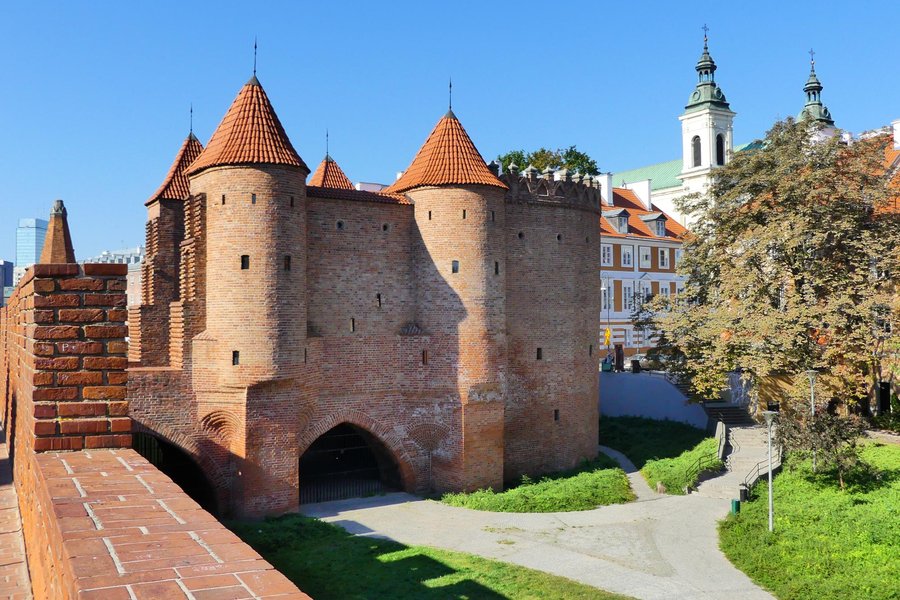
Warsaw Old Town was razed by the Nazis in 1944, so the WHS designation was awarded for the restoration effort that is still ongoing. As such, we had to view it as a construction project instead of an old town. The job done is remarkable, but one always wonders if things are made more for the tourists, which are many. Mea culpa. As a tourist site, it is pleasant enough, with broad squares, the church spires, classical and Gothic architecture abound. But there isn’t anything that makes it different from any other old European city. There are no WHS class churches, no architecture master pieces, no stunning river views.
It’s worth a visit for the 20th Century history, along with other scars.
Keep reading 0 comments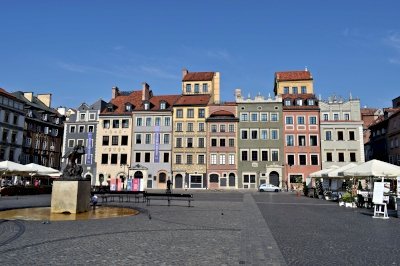
It isn’t too difficult to imagine a world in which the reconstruction of Warsaw after World War II was done in such a way to make the city centre indistinguishable from every other concrete jungle in eastern Europe. Indeed, large swathes of the city seems to be done in the stereotypical brutalist style with wide streets and a fair amount of greenery between the tower blocks, which was no doubt supposed to be highly efficient but doesn’t make for the most interesting visiting experience. For my visit, I was staying near the university on the southwest side of the city but it was straightforward to head into the city centre on the excellent tram network that I made use of most nights. There was also an underground metro although I had very little experience with that. The tram led past the towering Palace of Science and Culture with its distinct Stalinist style that has come, for better or worse, to be symbolic of Warsaw and its relatively recent Communist past. However, it was surrounded by the glass and steel skyscrapers of the capitalist present and the city centre seemed to be a hive of construction activity.
With a free afternoon, I made my way on the tram to the stop outside the National Museum (Muzeum Narodowe) but sadly did not have time to venture inside. Instead, I disembarked the tram, which necessitates crossing a very busy road as there was no pedestrian underpass at that tram stop, then headed …
Keep reading 0 comments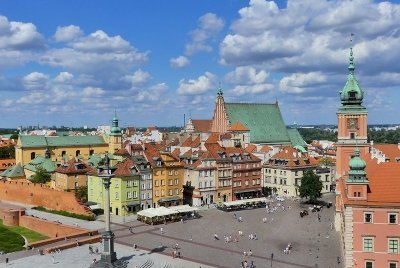
I visited this WHS in August 2020. The near total reconstruction of the Historic Centre of Warsaw is really outstanding and unlike other WHS such as Regensburg in Germany or Torun in Poland itself, the quality of the reconstruction is so high and on such a large but meticulous scale that it wouldn't be unheard of to think that most of the old city centre is from Medieval times.
Warsaw was deliberately annihilated in 1944 as a repression of the Polish resistance to the German occupation. The capital city was reduced to ruins with the intention of obliterating the centuries old tradition of Polish statehood. The rebuilding of the historic city, 85% of which was destroyed, was the result of the determination of the inhabitants and the support of the whole nation. The reconstruction of the old city centre in its historic urban and architectural form was the manifestation of the care and attention taken to assure the survival of one of the most important testimonial of Polish culture. The city as the symbol of elective authority and tolerance, where the first democratic European constitution of 1791 was adopted was rebuilt, including a holistic recreation of the urban plan, together with the Old Town Market, the town houses, the circuit of the city walls as well as the Royal Castle and important religious buildings.
I'd recommend starting your visit of the historic centre by entering through the Barbican gate and gazing at the different pretty motifs on most …
Keep reading 0 comments
I went with friends to Warsaw in April 2015 for the 17th International Chopin Piano Competition. Whilst there, we took the opportunity to explore the Historic Centre, which is a pretty small section of the centre of the city that showcases what the area was like prior to its destruction by Nazi Germany in the Second World War.
Over 85% of the city’s buildings were destroyed in the war, as depicted movingly in the Roman Polanski film The Pianist.
It was in response to the Warsaw Uprising of 1944 that the Germans took the decision to annihilate the city, destroying over 700 years of historical buildings ranging from the thirteenth to the twentieth century. The remarkable thing about what the people of Poland achieved in five years after the war was that they followed historical plans and imagery in great detail, enabling them to rebuild the city very much as it had been.
Keep reading 0 comments
For a big European capital, Warsaw does not have a large number of attractions, but enough to spend a pleasant day or two. The reason for the relative lack of sights is of course the immense destruction it suffered during WWII, and the Old Town was meticulously rebuilt in the following decades. If you don't look too closely, you could believe that you are walking through a town with many authentic medieval, Renaissance and Baroque buildings. The restored centre is quite small, however. Apart from the Old Town, the (in)famous Palace of Science and Culture merits a visit for its panoramic views of the city.
Keep reading 0 comments
Warsaw's Old Town is a dream for every city break. A large part of the old town was destroyed during the Second World War, but rebuilt. There are also plenty of small shops and restaurants that invite you to a short stop. The old town flows from an incredible charm.
Keep reading 0 comments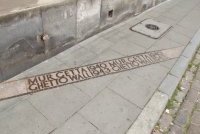
Like Jorge I stayed at the hotel Gromada near the airport, as I was leaving next day for Riga. Very conveniently bus #175 stopped outside the hotel and took me directly to the Stare Miasto. So I was able to maximise my time visiting the WHS, first in the afternoon, then again early next morning.
I enjoyed seeing the imposing Royal Palace and the colourful baroque buildings surrounding the squares. But in addition there were the more sombre reminders of the Ghetto, the Nazi persecution and the Uprising.
Keep reading 0 comments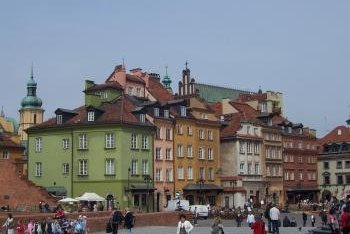
I was really impressed by Warsaw. I had heard some pretty mediocre reports about the city from others that had visited, however I really enjoyed the two days I spent there at the start of my little jaunt.
The World Heritage Site itself is the reconstructed old town, and whilst it may not be as glorious as some of the other Central European cities on the list, it has an incredible story of rebuilding after near total destruction. It was actually a little bigger than I was expecting it to be, and the sgraffito wall decorations were some of the finest examples I have seen. It is pretty evident that this site has been rebuilt, however I think this is quite good as it enables people to ‘read’ the restoration, instead of just trying to pass it off as being more authentic. I kept on returning for strolls down different streets and think I probably walk down every one with-in the WHS.
Aside from the old town I really liked Warsaw, admittedly the Central station is a little grim looking but there are plenty of other worthwhile places to visit; most strikingly the Palace of Science and Culture, but we also had great fun venturing off to more remote parts of the centre to see the monuments and museum relating to the history of the city in the Second World War. Perhaps my favourite thing though was the relaxed atmosphere we found, from queuing in Milk Bars to bar hopping …
Keep reading 0 comments
Some weeks ago I enjoyed for one week the wonderful and interesting town Warsaw and I liked it very much. Especially the combination of the old and the new in this town is quite interesting. A special impression for me was also the performances in the opera house TEATR WIELKI (e.g. BALLET DE LORRAINE, THE QUEEN OF SPADES ).
The market-place is really wonderful. But one negativ thing I have to mention with this old town square: Unfortunately it was started to change the wooden windows to plastic windows with no proportions and other dimensions. It would be terrible if more houses would change in this way. So please stop these plastic windows otherwise the market place would look like a plastic Disney World and the place would loose its wonderful atmosphere.
Keep reading 0 comments
After hearing mixed reviews of the Polish capital, I decided that it would be worth checking out. I headed there from Krakow and though first impressions weren't the best [the Central Train Station was quite ugly], my mind was changed once I got to discovered the rest of the city.
The area known as Srodmiescie, with it's skyscrapers and modern buildings blends in with XIX century tenements and eventually the city's historic core, which can be reached by walking up the colourful promenade known as the Royal Route. It looks quite original and I have to say that the conservationists did a good job reconstruction the street. The Old Town and New Towns are interesting as well, offering everything from over-priced dining and junk to really good Italian Ice Cream. All in all, it's a nice place to idle around.
The city itself is one that is in a state of transformation. The grime and greyness that so many associate with it is slowly being replaced with glass and steel and fresh paint. In 10-15 years, it'll be a totally different place. Though it's not Krakow, I recommend Warsaw, especially if you enjoy modern architecture.
Keep reading 0 comments
